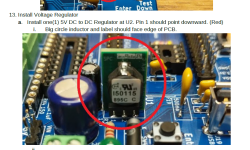Just completed the "Pi Zero 16 SMD" board. I had previously made the BBB16 , 24 pin 16 Port Expansion and the 4 port Receiver Out .
I wanted to see how the Pi Zero would work compared to the more expensive BBB version. The board is SMD and I ordered the bare board and hand soldered it. The board goes together rather quickly, the parts are fairly cheap, and works well.
The only issue I had was with FPP. On the BBB boards I was able to use FPP 5.5, and the EEPROM worked well without signing. I did purchase two licenses for it and a larger setup (one 24 and one 48), so I could upgrade to FPP 7.4 and use with X-Light Connect. On the Pi Zero I could not get the unsigned EEPROM to work right, every time I would make changes to the outputs, it would revert back to the defaults. I even made the changes directly to "co-pixelStrings.json" file, and rebooted. Then if I made a change it would revert back. This was on FPP 4.6, 5.3 and 5.5. I then tried 7.4 with the unsigned EEPROM and it worked perfectly (only limited by 50 pixels per output). I purchased a license for the Pi Zero (24 outputs), signed the EEPROM and it works perfectly.
Don't be afraid of signing the EEPROMs, they have made it very easy and straight forward. I know I could have asked for a voucher for the boards, but I really try to do my part with moving FPP and these projects forward.
Included are the 3D bases I did for the Pi Zero and the 24 pin 16 port expansion.

